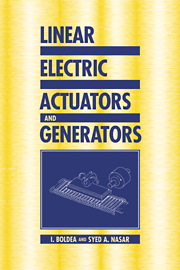Book contents
- Frontmatter
- Contents
- Preface
- Chapter 1 Magnetic Circuits, Fields, and Forces
- Chapter 2 Introduction to Linear Electric Actuators and Generators
- CHAPTER 3 Linear Induction Actuators
- CHAPTER 4 Linear Permanent Magnet Synchronous Actuators
- CHAPTER 5 Linear Reluctance Synchronous Actuators
- CHAPTER 6 Linear Switched Reluctance Actuators
- CHAPTER 7 Linear Stepper Actuators
- CHAPTER 8 Linear Electric Generators
- Index
Chapter 2 - Introduction to Linear Electric Actuators and Generators
Published online by Cambridge University Press: 19 September 2009
- Frontmatter
- Contents
- Preface
- Chapter 1 Magnetic Circuits, Fields, and Forces
- Chapter 2 Introduction to Linear Electric Actuators and Generators
- CHAPTER 3 Linear Induction Actuators
- CHAPTER 4 Linear Permanent Magnet Synchronous Actuators
- CHAPTER 5 Linear Reluctance Synchronous Actuators
- CHAPTER 6 Linear Switched Reluctance Actuators
- CHAPTER 7 Linear Stepper Actuators
- CHAPTER 8 Linear Electric Generators
- Index
Summary
In this chapter we present a general introduction to linear electric actuators (LEAs) and linear electric generators (LEGs). We will use the acronyms LEAs and LEGs consistently throughout the text. We begin with the definitions of LEAs and LEGs, although these definitions are not standardized in the profession. Subsequently, we will present a general discussion pertaining to the principles of operation and certain applications (existing and potential) of LEAs and LEGs.
TERMINOLOGY
Linear electric actuators (LEAs) are electromechanical devices which produce unidirectional or bidirectional short-stroke (less than a few meters) motion. In this regard, an LEA may be considered an electric motor in that both LEAs and electric motors internally develop electrical forces resulting in mechanical motion. However, the LEAs considered in this book have linear motion (or motion in a straight line), whereas electric motors have rotary motion. Moreover, unlike most electric motors, LEAs are commonly used for bidirectional, or reciprocating, motion.
Linear electric generators are electromechanical energy converters driven by prime movers undergoing reciprocating motion and converting mechanical power into single-phase ac power. It is to be noted that LEGs are not used for three-phase power generation, since the phase sequence of the generated voltage will reverse as the prime mover reverses its direction of motion.
Just as rotary electromagnetic machines do, LEAs and LEGs share the blessing of reversibility; that is, the same machine can act as an actuator or as a generator.
Information
- Type
- Chapter
- Information
- Linear Electric Actuators and Generators , pp. 33 - 44Publisher: Cambridge University PressPrint publication year: 1997
Accessibility standard: Unknown
Why this information is here
This section outlines the accessibility features of this content - including support for screen readers, full keyboard navigation and high-contrast display options. This may not be relevant for you.Accessibility Information
- 2
- Cited by
